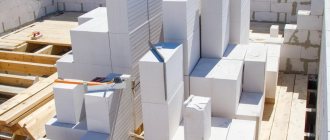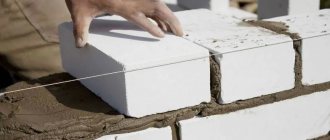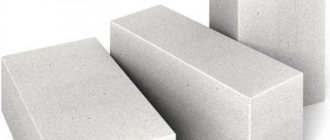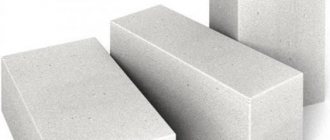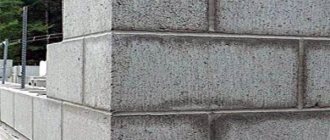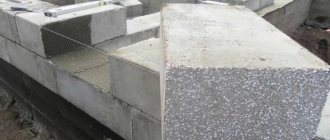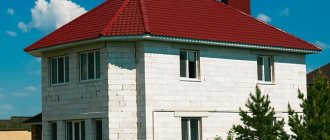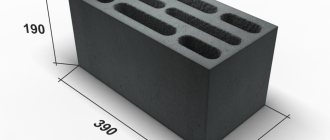And it cannot be said unequivocally that the higher it is, the better the material, since different types of structures require different density values.
This article will consider one type of aerated concrete products with a density of D500. What does this name mean, what indicators are included - read on.
Concept of the D500 brand
Aerated concrete blocks belong to the cellular type of autoclave-hardening concrete. Basically, they are produced in the form of a rectangular parallelepiped. On the end sides there may also be recesses for gripping the block with your hands, as well as ridge grooves for simplicity and strength of the masonry.
Aerated concrete consists of cement, sand, lime, water . Aluminum powder is gradually introduced into this mixture in such an amount that the resulting gas block of the required density is obtained, in this case D500 (d500).
Interesting : the more cement and sand in the material, the greater its strength will be.
Aluminum powder begins to interact with lime, as a result of which hydrogen is actively released, which, when the material hardens, forms irregularly shaped pores with a diameter of 1 to 3 mm (porosity ranges from 55 to 75% of the total mass of the block). The material obtains its final strength as a result of firing in an autoclave oven .
Products with density D500 are used in the construction of:
- Load-bearing walls (internal and external).
- Curtain walls.
- Partitions.
- Armopoyasov.
- Jumpers.
- Chimneys and ventilation ducts.
This material is widely used in the construction of garages, summer kitchens, sheds, outbuildings, private residential buildings with a maximum of 5 floors, as well as for insulating existing walls.
Weight
The specific gravity of an aerated concrete block is affected by the fillers used in their manufacture. Due to its specific gravity, the material is divided into several groups:
- Particularly light. The structure of the products contains many (85 percent) cells with air. Often such building materials are used to insulate buildings. 1 m3 of concrete of this type, as a rule, weighs less than 500 kilograms.
- Lungs. They are solutions with fillers such as shell rock or expanded clay (gas blocks, foam blocks). The weight of a cubic meter of building material is 500-1,800 kilograms - it all depends on the density of the building material. The heaviest component of the mixture is sand.
- Heavy. This type of product is considered more common than all others. The solution contains gravel and crushed stone. It is these components that determine how much the block will weigh. In most cases, a cubic meter of building material weighs about two tons or more. The mass of concrete is affected by cement, crushed stone, and sand.
- Particularly heavy. This mixture is considered the rarest. In a solution weighing two and a half to three tons, the bulk of its mass is made up of large-sized aggregate.
Return to contents
Characteristics: weight, frost resistance and other parameters
The concept of D500 means that 1 m3 contains 500 kg of solid components, everything else is air pores. The more these pores, the lighter the block, the lower the thermal conductivity, but the strength also becomes less. It turns out that gas blocks of grade 500 are colder than D300, but stronger .
| Key Features of the D500 | Indicators |
| Density | 500 kg/m3 |
| Strength | Class B2.5 - B3.5 (or 2-3 MPa) |
| Thermal conductivity | 0.12-0.13 W/(m×°C) |
| Frost resistance | F35-F100 |
| Porosity | From 55 to 75% |
| Weight | From 8 to 25 kg depending on the purpose of the blocks |
| Fire resistance | I and II classes |
| Shrinkage after hardening | 0.3 mm/m |
| Vapor permeability | 0.2 mg/(m×h×Pa) |
For comparison, below is a table with other densities:
What affects the weight of an aerated block?
The weight of the block depends on the density.
The weight of the gas block will depend on the density. This value is indicated on the stamp. For example, the designation D600 indicates that the density of aerated concrete is 600 kilograms per cubic meter. Thus, in 1m3 there are 600 kilograms of aerated concrete. If the density value is known, workers can calculate the mass of one or several pieces of gas blocks. To carry out calculations, you need to find out how many gas blocks there are in one cubic meter. For example, one product of the D500 brand, the dimensions of which are 200 by 300 by 600 millimeters, weighs about 18 kilograms.
Return to contents
Dimensions
The modern construction market offers many variations in block sizes. The table below shows some of them:
| Thickness, mm | Height, mm | Length, mm | Number of pieces in a pallet, pcs. |
| 75 | 200 | 610 | 240 |
| 100 | 200 | 610 | 180 |
| 100 | 250 | 625 | 96 |
| 150 | 200 | 610 | 120 |
| 200 | 250 | 600 | 48 |
| 250 | 250 | 600 | 38 |
| 300 | 250 | 600 | 30 |
| 400 | 200 | 600 | 40 |
| 400 | 250 | 625 | 24 |
| 400 | 250 | 600 | 32 |
| 300 | 200 | 600 | 50 |
| 150 | 250 | 625 | 76 |
| 200 | 250 | 625 | 58 |
Elements with a minimum thickness of 75 to 150 mm are suitable for the construction of partitions and non-load-bearing walls, products with a width of 200 to 250 mm can be used for outbuildings and houses that will only be lived in during the warm season, and blocks with a thickness of 300 to 400 mm are suitable for load-bearing structures.
Manufacturers
The Russian market offers aerated concrete blocks from the following manufacturers:
- “Ksella-Airblock-.
- Stonelight.
- Poritep.
- Bonolit.
- Aeroc.
Pros and cons of wall aerated blocks
Advantages of aerated concrete elements:
- Higher compressive strength and density than lower grades; good frost resistance.
- Low shrinkage rates after final hardening.
- Low weight of one block due to the porous structure.
- Smooth edges and clear geometry - allows you to lay out walls that are even on the plane, and then save on finishing.
- Good vapor permeability indicators mean that the walls can “breathe”, not retain moisture, but release it out. Therefore, on such walls there is a low probability of mold and mildew appearing.
- Possibility to build buildings up to 5 floors.
- Low price for finished products.
- Ease of use and laying - due to the low weight and smooth edges of the blocks.
- Fire safety.
- Safety from the environmental side - the material does not harm the health of the residents of the house and does not release toxic substances into the environment.
- High level of sound insulation.
- Ease of processing the material (it is easy to saw and cut).
But this aerated concrete has several disadvantages:
- High level of hygroscopicity.
The material easily absorbs moisture from rain and melting snow, and this impairs its density and thermal insulation properties. Therefore, external walls must be insulated and covered with a protective finish. The same drawback requires careful attention to the material during its warehousing and storage. If it is located outside, it is important to cover it with a thick film. - Fragility of the material. You need to work with it carefully so as not to knock off the corners and not make potholes in the blocks.
- The appearance of cracks after shrinkage. This disadvantage can be eliminated if you immediately do the external finishing of the elements, which will protect them from the influence of external factors.
- Low thermal conductivity compared to lower density grades D300 and D400.
Advantages of aerated concrete blocks
Due to its unique properties, aerated concrete is a very popular material among many construction companies. Among the main characteristics of this material are:
Figure 1. Standard sizes of rectangular blocks.
- Heat and sound insulation. Compared to brick, aerated concrete retains heat 3 times better and muffles noise 2 times more. This allows you not only to achieve cozy and comfortable living in a house made of aerated concrete blocks, but also to significantly reduce heating costs during the cold season.
- Water, frost and fire resistance. Aerated concrete can withstand more than 150 freeze-thaw cycles, is waterproof (material humidity does not exceed 5% under any external conditions), and also has a high degree of fire safety.
- Easy and quick installation. The weight of an aerated concrete block of standard sizes is about 23 kg, while the area of one such element replaces a masonry of 28 bricks. This allows not only to speed up construction work, but also to significantly save on mortar (its consumption is reduced by up to 7 times).
- Resistance to fungus and mold. Even at an ambient temperature of 29° C and a relative humidity of 97%, harmful microorganisms do not appear in the material. This is its great advantage over wood, since aerated concrete does not need to be additionally treated with an antiseptic when laying.
- Good machinability. This material is easy to cut, saw and drill. It does not crumble during processing, which allows you to achieve the required geometric dimensions without any problems.
In addition to the advantages, gas blocks also have some disadvantages. Firstly, this is an increase in the fragility of the material with a decrease in its density. Secondly, it has relatively low bending strength. Therefore, the choice of aerated concrete should be approached very carefully.
Counting material in one m3
It is produced according to the following scheme:
You need to check with the store selling the product about the dimensions of a certain material and calculate the total volume. The parameter for the block was calculated, taking into account the past case, to be about 0.036 m3. We divide the volume (one m3) by the volume of the block. Ultimately we get 27 units. This characteristic is usually written down in the invoice (or price list).
Construction documents take into account the volume of required material, which can be obtained by multiplying the area of the walls, take into account window openings, as well as doors, taking into account the density of the walls.
By calculating the amount of materials per cubic meter, multiplying it by volume, you can find out the total amount of blocks. It will be necessary for the construction of the future house. When making calculations, it is important to take into account that jumpers will be made under each window. Therefore, these areas do not need to be taken into account. It is only important to choose and buy future material.
How many aerated concrete blocks are in 1m3 (calculation example)
If you need to calculate how many gas blocks are in one cube, you need to perform two steps. First of all, you should measure the parameters of one gas block and determine the volume of the product in cubic meters. After this, the unit must be divided by the number obtained earlier. For example, if the parameters are 300 by 250 by 625 millimeters, then to calculate the volume of one gas block, it is necessary to calculate the product of all sides of the product in meters. It turns out: 0.3*0.25*0.6 = 0.04 cubic meters. Then we divide one cubic meter by the volume of the gas block: 1:0.04 = 21.3...pieces. Thus, there are 21 gas blocks in one cube.
To determine the dimensions of aerated concrete products, you can go to the websites of their manufacturers - there you can find tables that indicate all the values. Having found out exactly how many pieces of gas blocks there are in one cubic meter, you can begin to calculate the amount of building material for construction. It all depends on the parameters of the future structure. To make the necessary calculations of the material, in addition to its quantity, it is important to take into account the weight. Thus, knowing the number of gas blocks and the weight of one cubic meter of material, you can calculate the total mass.
Return to contents
